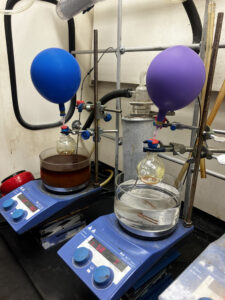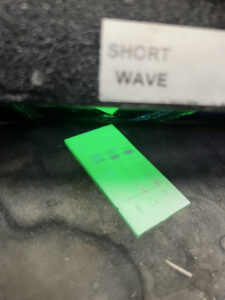This week in the Engle lab I have been able to do more reactions and more properly see the full functioning of the lab. We started the week by setting up two reactions called Sonogashira Reactions, where the goal is remove a hydrogen from a terminal C-C triple bond with an aryl group (call that aryl-1) and couple to a bromo-benzaldehyde (aryl-2). Aryl-2 contains a halogen (bromine or iodide) attached, and during the reaction, we remove the halogen from aryl-2 and the hydrogen from aryl-1 in order to couple the benzaldehyde and the alkyne (C-C triple bond).
To start, we use a highly sensitive scale to weigh out the masses of of our solid reagents and separately add them to a round bottom flask. we add trieth ylamine last because it is the base and solvent of our reaction. We did two different flasks and the difference between them was the type of aryl group we started with. Flask 1 had ethynylnaphthalene and Flask 2 had 2-fluorobenzene. We did this to show that the reaction can work with many types of aryl groups, not just one specific compound. After adding the reactants, we must start the reaction by putting in Copper Iodide and Pd(PPh)2 Cl2, which are the catalysts that will cause the coupling. Then, we need to seal the flask with only nitrogen in the top because we don’t want any air to accidentally react with any other things. Finally, we set them both in a bath of oil at 50 degrees Celsius, and magnetically rotate a stir-bar to constantly mix the solution. This reaction takes a long time so we left them overnight.
ylamine last because it is the base and solvent of our reaction. We did two different flasks and the difference between them was the type of aryl group we started with. Flask 1 had ethynylnaphthalene and Flask 2 had 2-fluorobenzene. We did this to show that the reaction can work with many types of aryl groups, not just one specific compound. After adding the reactants, we must start the reaction by putting in Copper Iodide and Pd(PPh)2 Cl2, which are the catalysts that will cause the coupling. Then, we need to seal the flask with only nitrogen in the top because we don’t want any air to accidentally react with any other things. Finally, we set them both in a bath of oil at 50 degrees Celsius, and magnetically rotate a stir-bar to constantly mix the solution. This reaction takes a long time so we left them overnight.
After returning the next day, we did a Thin Layer Chromatography (TLC) o n the mixtures, by dotting a sample of each on a silica plate with a capillary tube and setting them in 95% hexanes and 5% ethyl acetate. After allowing them to dry, we saw under a UV light that they both had completely used up the catalyst but still had some starting material left. So in order to get the most amount of product possible, we supplemented each one with more palladium-II and copper Iodide by injecting them into each flask dissolved in trielthylamine.
n the mixtures, by dotting a sample of each on a silica plate with a capillary tube and setting them in 95% hexanes and 5% ethyl acetate. After allowing them to dry, we saw under a UV light that they both had completely used up the catalyst but still had some starting material left. So in order to get the most amount of product possible, we supplemented each one with more palladium-II and copper Iodide by injecting them into each flask dissolved in trielthylamine.![]() After waiting another day, the starting material was basically all used up so we removed both flasks from the oil bath and filtered them through course celite to remove some unwanted by products. Then we placed on the Rotavap machine to vacuum out the solvents and leave us with a solid product. Then we place the solids in a vertical column and run a mixture of 98% hexanes and 2% ethyl acetate. We let that it run through into 20-40 different test tubes to isolate the product we want, Rotavap the final product, and finally we take an NMR to check our results.
After waiting another day, the starting material was basically all used up so we removed both flasks from the oil bath and filtered them through course celite to remove some unwanted by products. Then we placed on the Rotavap machine to vacuum out the solvents and leave us with a solid product. Then we place the solids in a vertical column and run a mixture of 98% hexanes and 2% ethyl acetate. We let that it run through into 20-40 different test tubes to isolate the product we want, Rotavap the final product, and finally we take an NMR to check our results.
Outside of the lab, this week I tried to go to the beach everyday and I succeeded. This time I was not stung by a stingray but my foot is still swollen. Me and my host parents went to a San Diego Padres game on Tuesday and It was very exiting. Profar, the padres shortstop hit a grand slam and started a fight in the same game so the entire stadium was loud and it got rowdy. Afterwards we walked around downtown SD before taking the public trolley home. On Saturday we had a group meetup with four other interns that are also in the San Diego area! We went to UTC, a large mall near the UCSD I am really enjoying this Internship! See you guys next week.



There are no comments published yet.